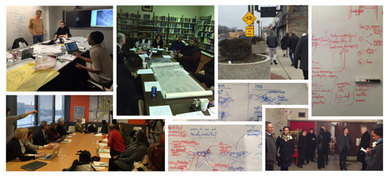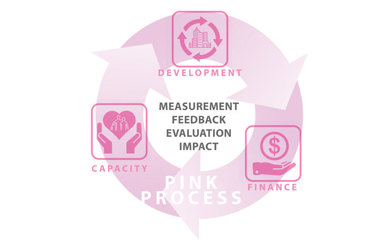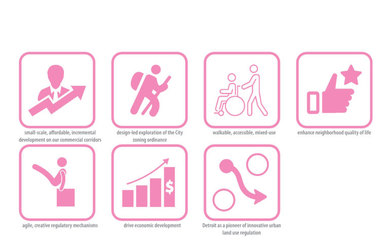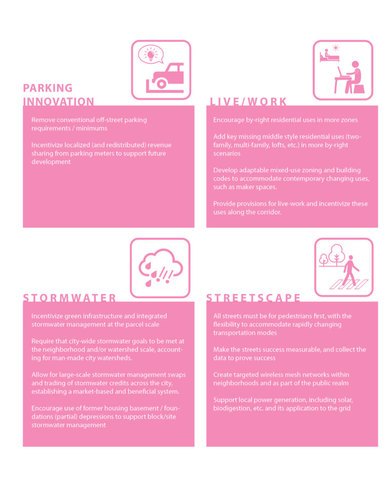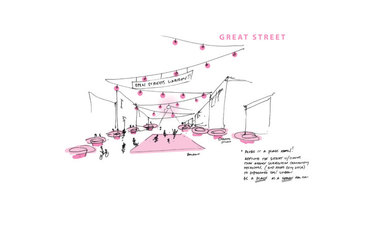Pink Zoning Detroit: Reducing Red Tape for Small-Scale Development, Part 1: The Pink Process
Zoning policy has been coming under increasing scrutiny for the role it too often plays in restricting urban redevelopment and limiting its potential and benefits. In a recent article for Bloomberg View, Justin Fox wished zoning a happy 100th birthday, then argued it was time to make it go away.
Pink Zoning Detroit is a new initiative to reduce zoning’s regulatory red tape and develop innovative mechanisms to advance neighborhood-based development projects. The goal of Pink Zoning Detroit is to help realize the pressing need for small scale, affordable, incremental development in Detroit through a creative, design-led exploration and redefinition of the city’s zoning ordinance, building code, and review procedures.
It has been energizing to be part of this precedent-setting process as a team leader for one of the three teams selected to advance this research project that targets three commercial corridors in the city. I’ve always been a firm believer that diversity enhances design, and the teams that have come together to support this process represent a rich variety of expertise, experiences and perspectives that will help envision a revitalized Detroit. In addition to SmithGroup, Farr Associates/PlaceMakers/CHA and Laavu teams consisting of designers, urban planners, academia, policy experts, sustainability strategists, urban revitalization and community engagement specialists have collaborated with the City of Detroit Planning and Development Department and key City stakeholders. Together we balance tactical measures with innovative approaches in a rich and exciting dialogue.
Our team was asked to focus our efforts on two key sites:
- Historic Asset. A mostly intact commercial corridor along East Warren at Outer Drive and adjacent to the historic Alger Theater
- Prime Parcel. A 5-acre vacant parcel where Gratiot Avenue meets the Dequindre Cut and adjacent to Eastern Market
To shape our recommendations we convened two community focus groups. From our neighbors, we heard:
- There are too many obstacles to opening a new business in the city.
- There is a general lack of transparency in the existing zoning process.
- We need a database/support group to connect residents and small businesses.
- Someone needs to “own” the corridor!
- Please fix the storm sewer. Our basements flood and our flood insurance is very high.
- We want a 100% occupied streetwall and more walkable/narrower/cleaner streets.
- We need activity. Especially for families/kids and to compete with the suburbs.
- Our streets are too wide and traffic volumes are really low.
- We have the opportunity to test some of the most flexible regulations in the city on this site.
While there are obvious outdated ordinances and provisions in the existing zoning code that should be changed, it is not our assignment to be editors. Our team has instead focused on a “Pink Process,” one that equally considers development goals (physical improvements), the financial mechanisms to incentivize change, and the capacity within the neighborhood to implement the change. This process creates the opportunity for a more transparent and legible engagement between neighborhood residents and city regulation. The intentional inclusion of measurement, feedback and evaluation of these goals as part of the City’s process will lead to proactive and supportive community impact, rather than punitive regulations that are discouraging and divisive.
In the context of this process, our team believes that Detroit has a significant opportunity to develop innovative regulatory mechanisms for stormwater management, streetscape development, and parking regulation, and to recombine traditionally separated live/work uses. These important components of the built environment provide avenues to achieving a meaningful impact for city residents. Detroit should build upon other successful national case studies to develop a Detroit-specific regulatory framework building on these themes:
The design discussion surrounding these themes was robust, emphasizing:
- Arising from the principals of Lean Urbanism, two main components of “Pink Zoning”: a zoning code that makes small development possible and affordable without subsidy and that encourages innovation.
- Great design can come through public participation.
- The need for clear and simple graphics and animation to re-introduce what real urban living means for Detroit.
- Creativity regarding short-term uses that will transition to longer-term development projects, including housing, mixed-use development, flexible public spaces, and anchors.
These themes will be tested against the City’s existing approval processes to identify how City codes or regulations may be changed to make redevelopment simpler. The process requires a fast and intense design mentality that is uniquely Detroit, but will yield innovations that are applicable to other major American cities. We believe that ensuring more thoughtful, accessible, and inspiring urban design and development is critical to Detroit’s sustained recovery. Our team approach emphasizes collaboration with partners in the City, design community, and neighborhoods to rapidly envision new futures and outline regulatory strategies that respond to Detroit’s unique needs while supporting great design.
Check back in the coming months for updates on our progress. We’ll be giving dynamic design form and vision to the reimagined framework to show how the Historic Asset and Prime Parcel sites could be transformed through Pink practices. By summer 2017 we’ll see new precedents for thinking about urban regeneration in Detroit.
